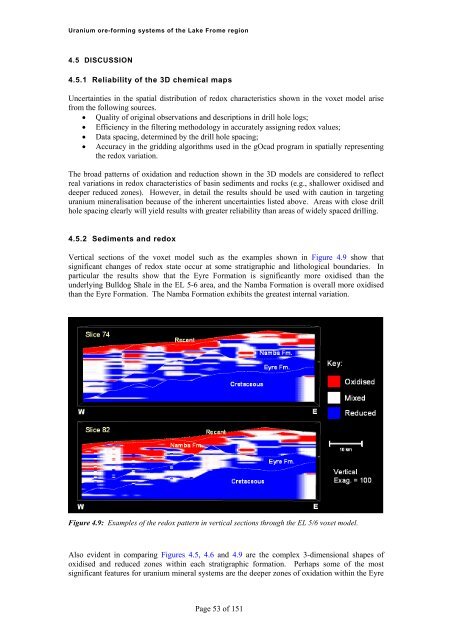Uranium ore-forming systems of the - Geoscience Australia
Uranium ore-forming systems of the - Geoscience Australia
Uranium ore-forming systems of the - Geoscience Australia
Create successful ePaper yourself
Turn your PDF publications into a flip-book with our unique Google optimized e-Paper software.
<strong>Uranium</strong> <strong>ore</strong>-<strong>forming</strong> <strong>systems</strong> <strong>of</strong> <strong>the</strong> Lake Frome region4.5 DISCUSSION4.5.1 Reliability <strong>of</strong> <strong>the</strong> 3D chemical mapsUncertainties in <strong>the</strong> spatial distribution <strong>of</strong> redox characteristics shown in <strong>the</strong> voxet model arisefrom <strong>the</strong> following sources. Quality <strong>of</strong> original observations and descriptions in drill hole logs; Efficiency in <strong>the</strong> filtering methodology in accurately assigning redox values; Data spacing, determined by <strong>the</strong> drill hole spacing; Accuracy in <strong>the</strong> gridding algorithms used in <strong>the</strong> gOcad program in spatially representing<strong>the</strong> redox variation.The broad patterns <strong>of</strong> oxidation and reduction shown in <strong>the</strong> 3D models are considered to reflectreal variations in redox characteristics <strong>of</strong> basin sediments and rocks (e.g., shallower oxidised anddeeper reduced zones). However, in detail <strong>the</strong> results should be used with caution in targetinguranium mineralisation because <strong>of</strong> <strong>the</strong> inherent uncertainties listed above. Areas with close drillhole spacing clearly will yield results with greater reliability than areas <strong>of</strong> widely spaced drilling.4.5.2 Sediments and redoxVertical sections <strong>of</strong> <strong>the</strong> voxet model such as <strong>the</strong> examples shown in Figure 4.9 show thatsignificant changes <strong>of</strong> redox state occur at some stratigraphic and lithological boundaries. Inparticular <strong>the</strong> results show that <strong>the</strong> Eyre Formation is significantly m<strong>ore</strong> oxidised than <strong>the</strong>underlying Bulldog Shale in <strong>the</strong> EL 5-6 area, and <strong>the</strong> Namba Formation is overall m<strong>ore</strong> oxidisedthan <strong>the</strong> Eyre Formation. The Namba Formation exhibits <strong>the</strong> greatest internal variation.Figure 4.9: Examples <strong>of</strong> <strong>the</strong> redox pattern in vertical sections through <strong>the</strong> EL 5/6 voxet model.Also evident in comparing Figures 4.5, 4.6 and 4.9 are <strong>the</strong> complex 3-dimensional shapes <strong>of</strong>oxidised and reduced zones within each stratigraphic formation. Perhaps some <strong>of</strong> <strong>the</strong> mostsignificant features for uranium mineral <strong>systems</strong> are <strong>the</strong> deeper zones <strong>of</strong> oxidation within <strong>the</strong> EyrePage 53 <strong>of</strong> 151
















